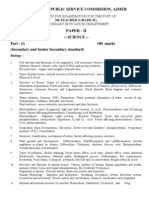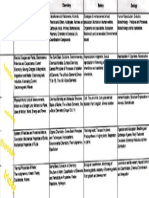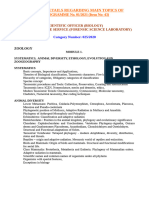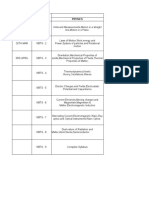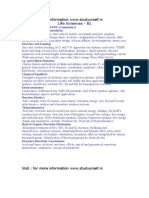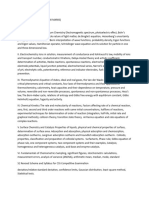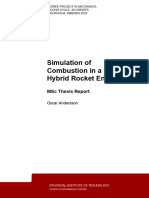Manipal M.SC Clinical Embroyology Syllabus 2020
Manipal M.SC Clinical Embroyology Syllabus 2020
Uploaded by
anuCopyright:
Available Formats
Manipal M.SC Clinical Embroyology Syllabus 2020
Manipal M.SC Clinical Embroyology Syllabus 2020
Uploaded by
anuOriginal Description:
Original Title
Copyright
Available Formats
Share this document
Did you find this document useful?
Is this content inappropriate?
Copyright:
Available Formats
Manipal M.SC Clinical Embroyology Syllabus 2020
Manipal M.SC Clinical Embroyology Syllabus 2020
Uploaded by
anuCopyright:
Available Formats
aglasem.
com
Manipal Entrance Test (MET) 2020 Syllabus
Program Institute
M.Sc. Clinical Embryology Kasturba Medical College (KMC), Manipal
MET 2020 Test Details
Test Duration: 120 minutes
Total Questions: 120 MCQs covering Zoology (40 questions), Chemistry & Biochemistry (40 questions), Basic Biology &
Embryology and Cell Biology (40 questions)
Marking Scheme: +4 for every correct answer, -1 for every wrong answer, 0 for every unattempted question
Student can register for a total of 2 attempts based on Test Centre / Slot availability, best score amongst the attempts will be
considered for the ranking
ZOOLOGY
Contribution of scientists to society: Introduction to biological concepts, Biographies and contributions of scientists: Charaka,
Sushrutha, CharlesDarwin, John Gregor Mendel, Louis Pasteur, A.I. Oparin, J.B.S. Haldane, J. C. Bose, Hermann Joseph Mueller,
J.D. Watson, Francis Harry Compton Crick, Har Gobind Khorana, Francois Jacob and Jacques Monod, Marshall W Nirenberg and
Frederick Sanger, Barbara McClintock, Venkatraman Ramakrishnan and others
Trends in animal body evolution (germ layers, symmetry, body cavity, etc.), Principles of animal classification, nomenclature
and concept of species, General characteristics and classifications: Protozoa: Type study: Paramecium (structure and
reproduction), Porifera: Type study: Leucosolenia, types of spicules and cells, water canal systems, Cnideria: Type study: Obelia
(structure and life cycle), structure of nematocyst, Platyhelminthes: Type study: Fasciola hepatica (structure and life cycle),
Nematoda: Type study: Ascaris (structure and life cycle), Annelida: Type study: Nereis (morphology), metamerism,
Arthropoda: Type study: Paneus (morphology), life cycles of silk worm, Mollusca: Type study: Lamellidens (shell structure and
internal anatomy), Echinodermata: Type study: Star fish (morphology), water vascular system, Fishes: Type study: Scoliodon
(morphology), scale types, accessory respiratory organs in fishes, migration in fishes, Amphibia: Type study: Rana tigrina
(morphology), digestive system, urogenital systems and respiratory system, Parental care in Amphibia, Reptilia: Amniotic egg,
identification of poisonous and non-poisonous snakes, poison apparatus and mechanism of biting, Jacobson’s and pit organs, snake
venom and its importance, Aves: Type study: Ostrich (morphology), flight adaptations, flightless birds, Mammalia: Type study:
Rat (morphology), dentition in mammals, adaptive radiations in mammals
CHEMISTRY & BIOCHEMISTRY
Periodic properties: Atomic radius, covalent, ionic & van der Waal’s radii, ionization energy, electron affinity and
electronegativity – definition, trends in periodic table, Acids and Bases: Arrhenius, Bronsted-Lowry, Lux-Flood, Solvent system
and Lewis concepts of acids and bases with examples. Conjugate acid-base pairs. Limitations of the theories. Hard and Soft Acids
and Bases (HSAB): Classification of acids and bases as hard and soft-examples and comparison, Pearson’s HSAB concept-acid
base strengths and hardness and softness. Electronegativity and hardness and softness – explanation, Bioinorganic chemistry:
Photosystems, porphyrins, metalloenzymes, oxygen transport, electron- transfer reactions; nitrogen fixation, Thermodynamics:
Introduction, terminologies associated with thermodynamics, 1st law of thermodynamics, Heat capacity, relation between Cp and
Cv (no derivation), Joule Thomson effect, 2nd law of thermodynamics, entropy and its significance. Gibbs free energy and
Helmholtz free energy, their relationships. Thermodynamics of biological systems - importance of Gibbs free energy, G, Ionic
Equilibria: Common ion effect, solubility product and application in salting out soap and purification of common salt,
Henderson’s equation, buffer solutions, buffer action, buffer capacity, pH values of buffer mixtures, preparing buffers of desired
pH, hydrolysis of salts, hydrolysis constants, relationship between kh, ka, kb and kw for various types of salts, degree of hydrolysis,
Chemical kinetics: Law of mass action, Rate of reaction, Order and molecularity of reaction, I, II & III order reactions, Derivation
of rate equations for I, II and nth order reactions, determination of order (differential, half life and isolation methods). Effect of
temperature of reaction rates- Arrhenius equation, Oils, Fats & Waxes: Composition of oils, fats & waxes, analysis of fats and
oils - Acid value, saponification value, iodine value, Polenske value, Reichert-Meissl value, acetyl value, manufacture of soap,
cleaning action of soaps & detergents, QSAR: The basic concepts of structure activity relationships (SAR) and quantitative
structure activity relationships (QSAR), QSAR parameters – Physiochemical parametersLipophilicity –Electronic parameters,
Manipal Academy of Higher Education (MAHE) www.manipal.edu 1
aglasem.com
Manipal Entrance Test (MET) 2020 Syllabus
Steric parameters, effect of electronic and steric parameters on lipophilicity. Hansch analysis, significance of slopes and intercepts
in Hansch analysis. 3D QSAR approach, Stereochemistry of Organic Compounds: Optical isomerism-elements of symmetry,
chirality, enantiomers, optical activity, properties of enantiomers- chiral and achiral molecules with two stereogenic centresEg.,
Lactic acid and Tartaric acid.. Diastereomers-definition & examples, threo and erythro diastereomers, meso compounds-definition
and examples, Resolution of enantiomers – mechanical, chemical and biochemical methods. Relative and absolute configuration,
sequence rules, D&L, R&S systems of nomenclature. Geometrical isomerism, cis-trans, E-Z, syn-anti configurations, Green
Chemistry: Definition and principles, planning a green synthesis in a chemical laboratory, Green preparation-Aqueous phase
reactions, solid state (solventless) reactions, photochemical reactions, Phase transfer catalyst catalysed reactions, enzymatic
transformations & reactions in ionic liquids. Biochemistry: Biomolecules, Carbohydrates: Definition. Classification -
monosaccharides (ribose, deoxyribose, glucose, fructose and galactose), oligosaccharides (maltose, sucrose and lactose) and
polysaccharides (starch, glycogen, cellulose, pectin, chitin and agar agar). Biological significance, Proteins: Definition.
Classification - simple proteins (albumins, globulins, histones, actin, myosin and keratin), conjugate proteins - Chromoproteins
(haemoglobin), glycoproteins (mucin of saliva), phospoproteins (casein of milk) and lipoproteins (lipovitelline of egg yolk).
Biological significance of amino acid and proteins, Lipids: Definition. Classification - Simple lipids - oils (vegetable oil and oil of
animal origin), fats (butter) and waxes (beeswax), Compound lipids - phospholipids (lecithin and cephalin) and sphingolipids
(cerebrosides), Related compounds - steroids (estrogen, progesterone and testosterone), sterols (cholesterol) and prostaglandins.
Biological significance, Nucleic acid: Occurrence, basic chemical composition (nucleoside and nucleotide), type (DNA and RNA)
and functions, Enzymes: Definition, properties, classification based on functions. Mode of action - induced fit theory of Koshland,
Metabolism of carbohydrates and lipids
BASIC BIOLOGY & EMBRYOLOGY
Introduction to Biology: Definition of Biology and its main branches - Botany and Zoology. Scope of Biology. Branches of
Biology. Classical branches - morphology, cytology, histology, anatomy, physiology, developmental biology, biosystamatics,
genetics, ecology, organic evolution and palaeontology. Interdisciplinary branches - biophysics, biochemistry and biostatistics.
Applied branches and career prospects - agriculture, entomology, silviculture, pathology, apiculture, microbiology and
bioinformatics. Role of biology in dispelling myths and disbeliefs, Origin of Life and Organic Evolution: Origin of life:
Introduction. Concept of abiogenesis and biogenesis (experimental evidences not required). A.I.Oparin’s Theory of chemical
evolution of life (Views of Haldane and Sidney Fox to be mentioned). Stanley Miller’s experiment in support of chemical
evolution. Divergent and convergent evolution. Evolution of man. Organic evolution: Introduction. Darwin’s Theory (DDT
resistance in mosquitoes and industrial melanism in Peppered moth, to illustrate natural selection to be quoted as examples). Brief
account of Mutation Theory. Neo Darwininism - Introduction, Darwinian concept vs Neo Darwinian concept (gene pool and gene
frequency), Hardy - Weinberg Law and sources of variations as evolutionary force - sexual reproduction, genetic drift, gene flow,
mutation and isolation (reproductive and geographic), Cell Biology: Cell structure: Structure and functions of cell components -
cell wall, plasma membrane (fluid mosaic model), endoplasmic reticulum, plastids (brief), mitochondria (brief), Golgi complex,
Ribosomes, Lysosomes, Centrosome, vacuole and nucleus - nuclear envelope (nuclear pores and nuclear lamina) nucleoplasm,
nucleolus and chromatin. A brief account of ergastic substances (mention about reserve food, secretory and excretory substances
with examples). Differences between plant cell and animal cell. Cytoskeleton, cilia, flagella, centriole, Chromosomes: Discovery,
shape, size and number of chromosomes, Autosomes and allosomes; Karyotype and idiogram. Chemical composition and function.
General structure - Concept of centromere (primary constriction), secondary constriction, satellite, kinetochore, telomere. Types
of chromosomes based on the position of centromere. Ultrastructural organization of the eukaryotic chromosome - nucleosome
model. Numerical aspects of chromosomes: A brief note on aneuploidy (monosomy and trisomy) and euploidy (haploidy, diploidy
and polyploidy), Cell Reproduction: Cell division and types. Concept of cell cycle. Mitotic division and significance. Meiotic
division and its significance. Cancer - meaning of cancer, benign and malignant tumours, characters of cancer cells, types of cancer
(Carcinoma, Sarcoma, Lymphoma and Leukemia), causes of cancer (physical, chemical and biological carcinogens with
examples). Concept of cell senescence and apoptosis. Gene: The gene, the genetic code and its characteristics, genetic control of
protein synthesis (transcription and translation) and Lac operon. Concept of gene (prokaryotic and eukaryotic). Genetics:
Mendelian genetics: Mendel and his work. Definitions of the following terms: Allele, Phenotype, Genotype, Homozygous and
Heterozygous. Principles of inheritance, dominance, law of segregation (purity of gametes) and law of independent assortment.
Monohybrid cross, Dihybrid cross and Test cross, Deviations from Mendelian laws: Incomplete dominance: Example - Flower
Manipal Academy of Higher Education (MAHE) www.manipal.edu 2
aglasem.com
Manipal Entrance Test (MET) 2020 Syllabus
colour in Mirabilis jalapa. Pleiotropy, Polygenic inheritance, chromosomal theory of inheritance, Sex determination, Linkage and
crossing over, Pedigree, Multiple allelism: Example - ABO blood groups and their inheritance in man: Blood typing; Rh factor
with a note on erythroblastosis foetalis. Sex linked inheritance in man: Example - Inheritance of colour-blindness , hypertrichosis
in man, Phenylketonuria, Genetic disorders in man: Chromosomal disorders - Down’s syndrome, Klinefelter’s syndrome,
Turner’s syndrome and Cri-du-Chat syndrome. Gene disorders - Sickle cell anaemia, haemophilia, Thalassemia.
Embryology: Male reproductive system: Anatomy of male reproductive system, structure and function of testes, histology of
testes, accessory male sex glands and their function, spermatogenesis, regulation of spermatogenesis, structure of spermatozoa.
Female reproductive system: Anatomy of female reproductive system, structure and function of ovary, histology of ovary,
menstrual cycle, folliculogenesis and oogenesis, regulation of oogenesis, structure of mature oocyte, Hormones: Classification of
hormones, mechanism of action of hormones, regulation of hormone action, endocrine disorders in reproduction, Fertilization:
Sperm oocyte interaction and fertilization, early embryo development, implantation, structure and function of placenta
CELL BIOLOGY
Cell Structure: Prokaryotic cell and Eukaryotic cell, Model Organisms: E. coli, Yeast, Flies, Fish, Worms and Mice. Membrane
Enclosed Organelles: Nucleus, Endoplasmic Reticulum, Golgi Apparatus, Lysosomes, Endosomes, Mitochondria, Peroxisomes.
Cytoskeleton: Intermediate Filaments, Microtubules, Actin Filaments. Cell-Division Cycle: Eukaryotic Cell Cycle, Mitosis,
Cytokinesis, Meiosis, Fertilization. Tissue Architecture: Extracellular Matrix, Epithelial Sheets, Cell Junctions, Cell-Cell
Adhesion, Cell-Matrix Adhesion, Architecture of cells in Brain , Heart & Liver & Skin. Immunology: Cells of Immune System,
Humoral Immunity, Cell Mediated Immunity. Tissue Maintenance and Self Renewal: Renewal of tissues, Resident Stem Cells
in Different Tissues, Hematopoitic Stem Cell, Therapeutic cloning, Reproductive Cloning. Induced Pluripotent cells Principles
and Methodology. Cancer: Properties of cancer cells: Proliferation, Invasion and Metastasis; Gene Mutations, Oncogenes and
Tumor Supressor Genes.
Best of Luck
Updated: Nov 4, 2019
Manipal Academy of Higher Education (MAHE) www.manipal.edu 3
You might also like
- Power Efficient Mini Inverter ProjectDocument61 pagesPower Efficient Mini Inverter ProjectAmartya Roy100% (15)
- Valid SOP: Standard Operating ProceduresDocument10 pagesValid SOP: Standard Operating ProceduresShahid Raza100% (2)
- Practice Identifying Parts of The Scientific MethodDocument5 pagesPractice Identifying Parts of The Scientific MethodalexsenajonNo ratings yet
- Acoustics MCQDocument12 pagesAcoustics MCQAh Fe100% (4)
- VIT Syllabus PDFDocument43 pagesVIT Syllabus PDFexs19058No ratings yet
- Medicinal and Environmental Chemistry: Experimental Advances and Simulations (Part I)From EverandMedicinal and Environmental Chemistry: Experimental Advances and Simulations (Part I)No ratings yet
- JNTUH MSC Entrance Exam SyllabusDocument19 pagesJNTUH MSC Entrance Exam SyllabusAnweshaBoseNo ratings yet
- Biotechnology SpecificDocument2 pagesBiotechnology Specificabdolu531No ratings yet
- JhjiiDocument2 pagesJhjiiOppo VivoNo ratings yet
- Nat Jan 2020 SyllabusDocument2 pagesNat Jan 2020 SyllabusAditya RajNo ratings yet
- Paper - Ii: Rajasthan Public Service Commission, AjmerDocument7 pagesPaper - Ii: Rajasthan Public Service Commission, AjmerRohit DuggalNo ratings yet
- Syllabus For NEST 2016: General SectionDocument8 pagesSyllabus For NEST 2016: General Sectionlegit peter parkerNo ratings yet
- Institute of Chemical Technology Syllabus For M. Tech. BPT Entrance Exam 2010-2011Document3 pagesInstitute of Chemical Technology Syllabus For M. Tech. BPT Entrance Exam 2010-2011ArinjayKumarNo ratings yet
- Syllabus For Life Sciences (XL) : Indian Institute of Technology Bombay GATE 2013Document6 pagesSyllabus For Life Sciences (XL) : Indian Institute of Technology Bombay GATE 2013Shiv KumarNo ratings yet
- Syllabus - Biological Sciences (BL) : General BiologyDocument3 pagesSyllabus - Biological Sciences (BL) : General BiologyJaydeep SinghNo ratings yet
- Anu Image Maker Size 38x 25 950: Continued...Document1 pageAnu Image Maker Size 38x 25 950: Continued...kkNo ratings yet
- Jnu MSC Biotechnology Syllabus: Atomic Structure: Bohr's Theory and Schrödinger Wave Equation Periodicity inDocument3 pagesJnu MSC Biotechnology Syllabus: Atomic Structure: Bohr's Theory and Schrödinger Wave Equation Periodicity inSubhajit DuttaNo ratings yet
- Bioinformatics SyllabusDocument5 pagesBioinformatics Syllabusvarmaria004No ratings yet
- Adobe Scan 30 Apr 2023Document1 pageAdobe Scan 30 Apr 2023fsza037No ratings yet
- Biochemistry and Metabolism Author Goa UniversityDocument9 pagesBiochemistry and Metabolism Author Goa UniversityalexabcdxyzNo ratings yet
- Federal University of Health ScienceDocument6 pagesFederal University of Health Scienceibrahimbabaibrahim125No ratings yet
- Last Leap For NEET - 2021 XII 78Document2 pagesLast Leap For NEET - 2021 XII 78Anvi RoseNo ratings yet
- Syllabus For Nest-2017: General SectionDocument8 pagesSyllabus For Nest-2017: General SectionVasuNo ratings yet
- Scientific Officer BiologyDocument20 pagesScientific Officer BiologyShabeer ali pcNo ratings yet
- Syllabi For Test Papers: 15.1 Biological Sciences (BL)Document8 pagesSyllabi For Test Papers: 15.1 Biological Sciences (BL)YASH SOLANKINo ratings yet
- Entrance Test Syllabus For Ph.D. (Sci.) All Branches (Admission 2022-2023)Document9 pagesEntrance Test Syllabus For Ph.D. (Sci.) All Branches (Admission 2022-2023)Kmborse Indian21No ratings yet
- Test Date Test Number PhysicsDocument2 pagesTest Date Test Number PhysicsSuyash SoniNo ratings yet
- Grand Test Series 2019-20 Group-1 (Batch: R1-R12), Group-2 (Batch: R13-R16, TT1-TT8, TT10)Document1 pageGrand Test Series 2019-20 Group-1 (Batch: R1-R12), Group-2 (Batch: R13-R16, TT1-TT8, TT10)Rachit ManochaNo ratings yet
- SGPGI SYLLABUS Medical Lab TechnologistDocument7 pagesSGPGI SYLLABUS Medical Lab TechnologistAkriti SinghNo ratings yet
- Gate Syllabus Life Science-XL and PatternDocument6 pagesGate Syllabus Life Science-XL and PatternBrijesh Kumar SinghNo ratings yet
- Syllabus 2023Document21 pagesSyllabus 2023indianmelacommunityNo ratings yet
- Syllabus 2023Document23 pagesSyllabus 2023vedant chaudhariNo ratings yet
- IISER Aptitude Test Syllabus 2024 240412 091615Document10 pagesIISER Aptitude Test Syllabus 2024 240412 091615Delna Mary ShibuNo ratings yet
- Proposed Major Test Plan (2022-2023) Neet Enthusiast Course: SyllabusDocument2 pagesProposed Major Test Plan (2022-2023) Neet Enthusiast Course: SyllabusSamragee MahajanNo ratings yet
- GATE Life SciencesDocument6 pagesGATE Life SciencesstudyurselfNo ratings yet
- Syllabus For Life Sciences: Looking For GATE Preparation Material? Join & Get Here Now!Document4 pagesSyllabus For Life Sciences: Looking For GATE Preparation Material? Join & Get Here Now!Shubhranshu PandeyNo ratings yet
- Faculty of Science PHD Entrance SyllabusDocument8 pagesFaculty of Science PHD Entrance SyllabusShubham JhaNo ratings yet
- Syllabus Gate Life SciencesDocument5 pagesSyllabus Gate Life SciencesAvi RoyNo ratings yet
- Food Science and Technology Second Level Courses SyllabusesDocument45 pagesFood Science and Technology Second Level Courses SyllabusesElisha ThompsonNo ratings yet
- Central Food Technological Research Institute Mysore Syllabus For Entrance Test For M.Sc. (Food Technology)Document2 pagesCentral Food Technological Research Institute Mysore Syllabus For Entrance Test For M.Sc. (Food Technology)rinkyguptaNo ratings yet
- Xi-Stu NR Neet FT-02Document1 pageXi-Stu NR Neet FT-02gufran khanNo ratings yet
- JIPMER Detailed SyllabusDocument5 pagesJIPMER Detailed SyllabusSafa SajidNo ratings yet
- OUCET BiochemDocument8 pagesOUCET BiochemMd Mouzam IbrahimNo ratings yet
- Chemistry Css SyllabusDocument6 pagesChemistry Css SyllabusAyesha BukhariNo ratings yet
- Junior Scientific Asssistant Pollution Control Board Chemistry Syllabus 1Document16 pagesJunior Scientific Asssistant Pollution Control Board Chemistry Syllabus 1Aghila SamjiNo ratings yet
- CHEMISTRY PART-A (40 Marks) Coordination Chemistry, Organometallic Compounds, Metal IonsDocument8 pagesCHEMISTRY PART-A (40 Marks) Coordination Chemistry, Organometallic Compounds, Metal IonschadalalawadamadhavNo ratings yet
- Syllabus For Life SciencesDocument6 pagesSyllabus For Life SciencesviveknarayanNo ratings yet
- Bio Technology SyllabusDocument15 pagesBio Technology SyllabusFaiz NasimNo ratings yet
- PG and MPhil SyllabusDocument947 pagesPG and MPhil SyllabusYa seen khanNo ratings yet
- Central Food Technological Research Institute Mysore Syllabus For Entrance Test For M.Sc. (Food Technology)Document2 pagesCentral Food Technological Research Institute Mysore Syllabus For Entrance Test For M.Sc. (Food Technology)Ezaz SojatNo ratings yet
- Niper Jee SyllabusDocument6 pagesNiper Jee Syllabuskumar HarshNo ratings yet
- GATE 2012 Life ScienceDocument3 pagesGATE 2012 Life ScienceMohit VermaNo ratings yet
- GATE 2021 Syllabus For Life Sciences XLDocument10 pagesGATE 2021 Syllabus For Life Sciences XLHarsh DwivediNo ratings yet
- M_Phil Chemistry(1)Document5 pagesM_Phil Chemistry(1)Ashish MahereNo ratings yet
- AM - Syllabus TSEAMCET 2022Document32 pagesAM - Syllabus TSEAMCET 2022ayesha tabassumNo ratings yet
- List of Topics To Study For The Scientific QuestionsDocument4 pagesList of Topics To Study For The Scientific Questionsfoviw93558No ratings yet
- Syllabus Biotechnology (BT) : The Biotechnology (BT) Test Paper Comprises of Biology, Chemistry, Mathematics and PhysicsDocument1 pageSyllabus Biotechnology (BT) : The Biotechnology (BT) Test Paper Comprises of Biology, Chemistry, Mathematics and PhysicsBarnali DuttaNo ratings yet
- Ph.D. Entrance Test SyllabusDocument3 pagesPh.D. Entrance Test Syllabusprabhnotdbg18No ratings yet
- Steps of Exam: Written Exam - 200 Marks Interview - 50 MarksDocument3 pagesSteps of Exam: Written Exam - 200 Marks Interview - 50 MarksakshikarneerajNo ratings yet
- TS EAMCET AM SyllabusDocument24 pagesTS EAMCET AM SyllabushoNo ratings yet
- ChemistryDocument4 pagesChemistryMalik Ameer Hamza BalochNo ratings yet
- Nanomaterials: Evolution and Advancement towards Therapeutic Drug Delivery (Part I)From EverandNanomaterials: Evolution and Advancement towards Therapeutic Drug Delivery (Part I)No ratings yet
- Steroids and their Medicinal PotentialFrom EverandSteroids and their Medicinal PotentialAbid Hussain BandayNo ratings yet
- 12th Class Chapter 19 NotesDocument25 pages12th Class Chapter 19 NotesMatham NarmadaNo ratings yet
- Mr. Saad Fida - 15x20 - On-Grid Elevated Structure - Proposal by COSMOS ENERGIES.Document14 pagesMr. Saad Fida - 15x20 - On-Grid Elevated Structure - Proposal by COSMOS ENERGIES.arhamali.brsNo ratings yet
- ComparatorDocument20 pagesComparatorprakaashtNo ratings yet
- Fire PumpDocument8 pagesFire Pumpprabhjot123100% (1)
- JCPSICE-2017 Set 23Document33 pagesJCPSICE-2017 Set 23geekspeak111No ratings yet
- Unsent Message To HSE Professionals in IndiaDocument3 pagesUnsent Message To HSE Professionals in IndiaProject Sales CorpNo ratings yet
- Transformer Life Extension Options and Considerations 20130820Document107 pagesTransformer Life Extension Options and Considerations 20130820baoHVLAB100% (1)
- AEEP2211 Lab 6Document29 pagesAEEP2211 Lab 660103041No ratings yet
- 22525 Energy Conservation & AuditDocument16 pages22525 Energy Conservation & AuditVikrant DakhaneNo ratings yet
- Royco 889Document2 pagesRoyco 889Anonymous oAbjbl4HNo ratings yet
- QuillsDocument4 pagesQuillsajostosNo ratings yet
- Iso 21013-4 2012 EnglishDocument16 pagesIso 21013-4 2012 EnglishLuis SuarezNo ratings yet
- 27 Jouan RC 10 10 (Escaneado - Inglés)Document31 pages27 Jouan RC 10 10 (Escaneado - Inglés)Ricardo RamírezNo ratings yet
- Lab HandoutDocument4 pagesLab Handoutmanikandan0000000No ratings yet
- "Configuration of Electric Vehicles": K Jambukeswar 3BR19EE038Document18 pages"Configuration of Electric Vehicles": K Jambukeswar 3BR19EE038Jeerigi DeepikaNo ratings yet
- How To Size Pump Suction PipingDocument2 pagesHow To Size Pump Suction PipingShebnemNo ratings yet
- Influencing Parameter of Strain Gauge BehaviorDocument15 pagesInfluencing Parameter of Strain Gauge Behaviorsneha sahuNo ratings yet
- Mcqs Preparation For Engineering Competitive ExamsDocument22 pagesMcqs Preparation For Engineering Competitive Examsengr.zubair34No ratings yet
- M14 Latihan SoalDocument5 pagesM14 Latihan SoalZulfachri RamadhanNo ratings yet
- 1 5KE6 8-HF-ComchipTechnologyDocument6 pages1 5KE6 8-HF-ComchipTechnologyVladimir MartynovNo ratings yet
- Electrical Installations RegulationsDocument19 pagesElectrical Installations RegulationsHabineza RemyNo ratings yet
- Engineering Science: Polytechnic Lab ManualDocument21 pagesEngineering Science: Polytechnic Lab ManualEnth LahNo ratings yet
- Simulation of Combustion Hybrid Rocket EngineDocument43 pagesSimulation of Combustion Hybrid Rocket EngineFabio BosioNo ratings yet
- lp11 924Document5 pageslp11 924api-170472102No ratings yet
- PNS BAFS PAES 215 - 2017 Coffee Roaster Methods of TestDocument20 pagesPNS BAFS PAES 215 - 2017 Coffee Roaster Methods of TestBluewishNo ratings yet
- Basic Design of Desalination Process (Water Arabia 2013)Document216 pagesBasic Design of Desalination Process (Water Arabia 2013)Yang Gul Lee100% (2)










